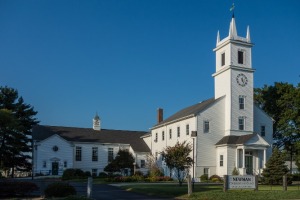I was recently doing some online research relating to the records of the Newman Congregational Church in East Providence, Rhode Island. A number of my ancestors, though Massachusetts residents, attended this church. I always wondered how a church in Rhode Island became the church of choice for families in Massachusetts, especially in an age when horses and walking were the two main means of transportation. I decided to do some investigating. As it turns out, the church began its existence in Massachusetts and has actually gotten around quite a bit in the intervening years.
To begin at the beginning, according to the Newman Congregational Church itself and the East Providence Historical Society, the church was founded in 1643. (But, according to the Rhode Island Historical Society, it was founded a bit earlier, in 1641.) It was built on land that was originally part of an area known as Seacunck, then renamed Rehoboth by a community of new settlers, English Puritans. Rehoboth was officially established as a town in 1645. In other words, the church has been around for quite awhile, 370 years, give or take.
The Newman Congregational Church remained in place for the first 170 years of its history. Then in 1812 Rehoboth’s borders changed. The western part of Rehoboth split off and became Seekonk. The church was on Seekonk land and became part of this new town. To complicate matters further, Seekonk and Rehoboth were part of an area that had been a bone of contention between Rhode Island and Massachusetts since the colonial period. In 1861 the United States Supreme Court awarded part of Pawtucket, Rhode Island, to Seekonk. According to the Rhode Island Historical Society, in “1862, the western part of the town of Seekonk was set off to the state of Rhode Island, and renamed East Providence.” When the dust settled, the Newman Congregational Church was now in an entirely different state. The church moved from Rehoboth to Seekonk, within Massachusetts, and then to East Providence, Rhode Island — without moving, physically that is. To complicate matters still further, the church’s address is listed as being in Rumford, which is actually a section of East Providence. Details such as these can be confusing to those researchers not used to the idea that divisions and villages such as Rumford can be parts of towns and cities rather than entities unto themselves.
In my classes I am always stressing the importance of local history and knowing the borders and boundaries for the locations where ancestors lived. What do you do if you can’t find records where you expect them to be? Look at a period map. Check the town or city history. If your ancestor’s family lived near a border, they may have belonged to organizations or attended religious services across that border in another town or county or state or province. Then again, it may be the border that changes. As the saga of Newman Congregational illustrates, “location” can be a most changeable factor, encompassing people and their homes and even their places of worship. Though this is the first instance that I’ve found of a church having border issues, I have a hunch it won’t be the last. And that, by the way, is how my Massachusetts ancestors ended up going to a Rhode Island church.
Additional sources consulted:
Historical Data Relating to Counties, Cities, and Towns in Massachusetts, prepared by William Galvin, Secretary of the Commonwealth. Boston, MA: New England Historic Genealogical Society, 1997. “Rehoboth, Bristol County” pp. 96-97; “Seekonk, Bristol County” pp. 103-104. MASS 974.4 M38H Note: Only the 1920 and 1948 editions of this reference work are available at Internet Archive.
History of Fall River: With Notices of Freetown and Tiverton as published in 1841 by Orin Fowler; Together with a Sketch of the Life of Rev. Orin Fowler, an Epitome of the Massachusetts and Rhode Island Boundary Question, an Account of the Great Fire of 1843, and Ecclesiastical Manufacturing, and Other Statistics. Fall River, MA: Almy and Milne Printers, 1862. “Massachusetts and Rhode Island: Boundary Question” pp. 67 – 71. Title linked to copy at Internet Archive.
vea/23 September 2016
Newton Free Library
Newton, Mass
Library website: http://www.newtonfreelibrary.net
Genealogy blog: https://thecuriousgenealogist.wordpress.com
Genealogy LibGuide: http://guides.newtonfreelibrary.net
